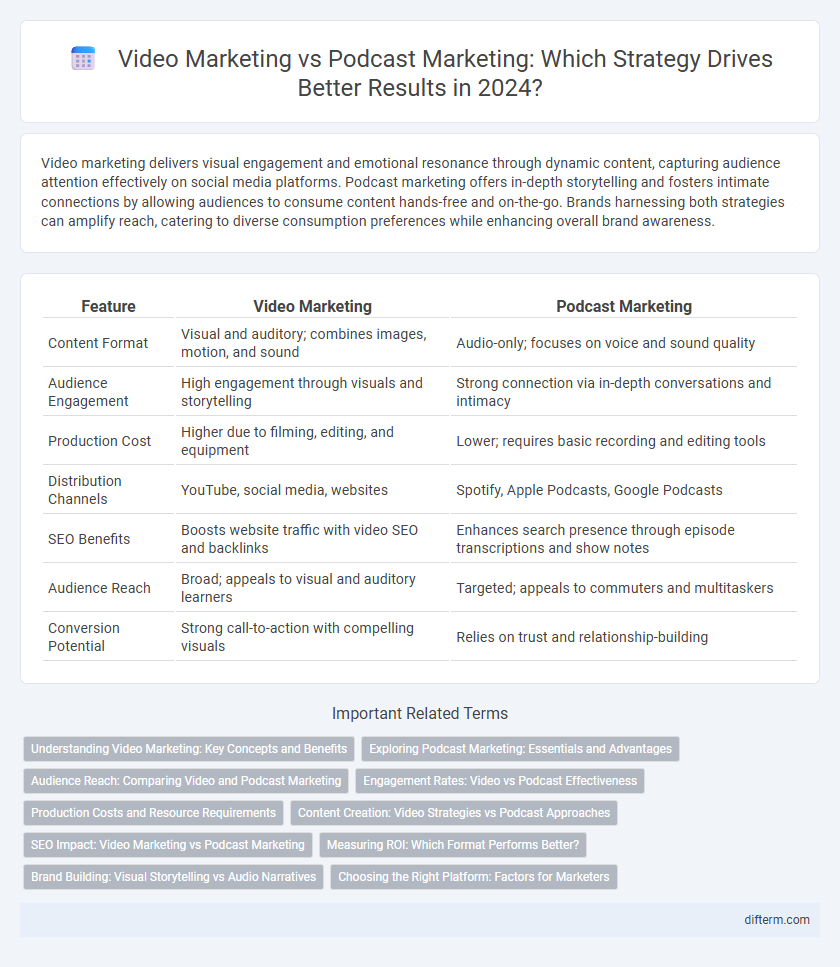Video marketing delivers visual engagement and emotional resonance through dynamic content, capturing audience attention effectively on social media platforms. Podcast marketing offers in-depth storytelling and fosters intimate connections by allowing audiences to consume content hands-free and on-the-go. Brands harnessing both strategies can amplify reach, catering to diverse consumption preferences while enhancing overall brand awareness.
Table of Comparison
| Feature | Video Marketing | Podcast Marketing |
|---|---|---|
| Content Format | Visual and auditory; combines images, motion, and sound | Audio-only; focuses on voice and sound quality |
| Audience Engagement | High engagement through visuals and storytelling | Strong connection via in-depth conversations and intimacy |
| Production Cost | Higher due to filming, editing, and equipment | Lower; requires basic recording and editing tools |
| Distribution Channels | YouTube, social media, websites | Spotify, Apple Podcasts, Google Podcasts |
| SEO Benefits | Boosts website traffic with video SEO and backlinks | Enhances search presence through episode transcriptions and show notes |
| Audience Reach | Broad; appeals to visual and auditory learners | Targeted; appeals to commuters and multitaskers |
| Conversion Potential | Strong call-to-action with compelling visuals | Relies on trust and relationship-building |
Understanding Video Marketing: Key Concepts and Benefits
Video marketing leverages visual storytelling to engage audiences, boost brand awareness, and improve conversion rates through dynamic content like tutorials, product demos, and testimonials. Key benefits include increased viewer retention, higher social media engagement, and enhanced SEO performance via video-rich search results. Brands using platforms such as YouTube, Instagram, and TikTok gain measurable insights through analytics, optimizing campaigns for targeted audience interaction.
Exploring Podcast Marketing: Essentials and Advantages
Podcast marketing leverages audio content to engage highly targeted audiences, offering deeper brand loyalty through intimate and consistent listener experiences. Essential elements include authentic storytelling, strategic guest appearances, and optimized distribution across popular platforms like Spotify and Apple Podcasts. Advantages encompass cost-effectiveness, enhanced SEO through transcriptions, and the ability to connect with niche markets often unreachable via traditional video marketing channels.
Audience Reach: Comparing Video and Podcast Marketing
Video marketing captures a broader audience reach by engaging viewers through visual and auditory stimuli, making it effective on platforms like YouTube, Facebook, and Instagram. Podcast marketing attracts a dedicated and niche audience, with listeners often spending more time per session, creating deeper brand engagement. Brands aiming for mass awareness tend to favor video, while those targeting specific interests or communities leverage podcasts for sustained attention.
Engagement Rates: Video vs Podcast Effectiveness
Video marketing typically yields higher engagement rates due to its visual and dynamic content that captures audience attention more effectively. Podcasts attract a loyal and deeply engaged listener base, especially in niche markets, but generally show lower interaction metrics compared to video content. Brands leveraging video marketing often experience increased shares, comments, and click-through rates, making it more effective for driving immediate audience actions.
Production Costs and Resource Requirements
Video marketing demands higher production costs due to equipment, lighting, and editing software expenses, while podcast marketing typically incurs lower costs with minimal setup involving microphones and audio editing tools. Resource requirements vary, as video campaigns require skilled videographers, editors, and on-screen talent, whereas podcasts primarily need audio producers and hosts. Budget-conscious marketers often prefer podcasts for cost efficiency, though videos offer more visual engagement opportunities despite higher investment.
Content Creation: Video Strategies vs Podcast Approaches
Video content creation leverages visual storytelling techniques, incorporating dynamic visuals, animations, and on-screen text to capture audience attention and enhance brand messaging. Podcast marketing emphasizes audio quality, engaging dialogue, and scripting to create immersive experiences that foster listener loyalty and deeper connections. Both strategies require tailored content planning, with video focusing on visual appeal and pacing, while podcasts prioritize voice tone and conversational flow to maximize audience engagement.
SEO Impact: Video Marketing vs Podcast Marketing
Video marketing significantly boosts SEO by increasing user engagement, dwell time, and providing rich multimedia content that search engines favor, enhancing visibility in search results. Podcasts contribute to SEO through creating niche, keyword-rich content that builds authority and attracts backlinks, although their direct impact on Google rankings is less immediate compared to videos. Combining both strategies leverages video's visual appeal and podcasts' deep content, maximizing organic reach and improving overall search engine performance.
Measuring ROI: Which Format Performs Better?
Video marketing typically delivers higher ROI through enhanced viewer engagement, conversion rates, and shareability across platforms like YouTube and social media. Podcast marketing excels in building niche audience loyalty and long-term brand affinity, generating valuable leads with lower production costs and sustained listener attention. Data from HubSpot reveals video content drives 66% more qualified leads monthly, while podcasts show a 40% increase in purchase intent among dedicated listeners.
Brand Building: Visual Storytelling vs Audio Narratives
Video marketing excels in brand building through compelling visual storytelling that enhances emotional connection and recall by showcasing product features and brand personality vividly. Podcast marketing leverages rich audio narratives to foster listener intimacy and trust, allowing brands to convey detailed stories, expert insights, and authentic voices that strengthen brand loyalty. Combining video's immersive imagery with podcasts' conversational depth creates a comprehensive brand experience maximizing audience engagement across multiple sensory channels.
Choosing the Right Platform: Factors for Marketers
Video marketing delivers high engagement through visual storytelling and is ideal for platforms like YouTube and Instagram, which support rich multimedia content. Podcast marketing excels in building loyal audiences by providing in-depth audio experiences, particularly on platforms such as Spotify and Apple Podcasts that prioritize episodic content. Marketers should evaluate audience preferences, content format compatibility, and distribution reach when choosing between video and podcast marketing platforms.
Video marketing vs podcast marketing Infographic

 difterm.com
difterm.com